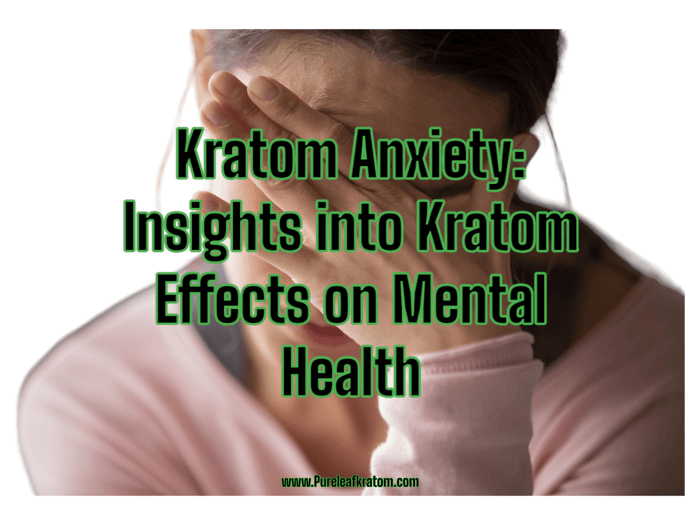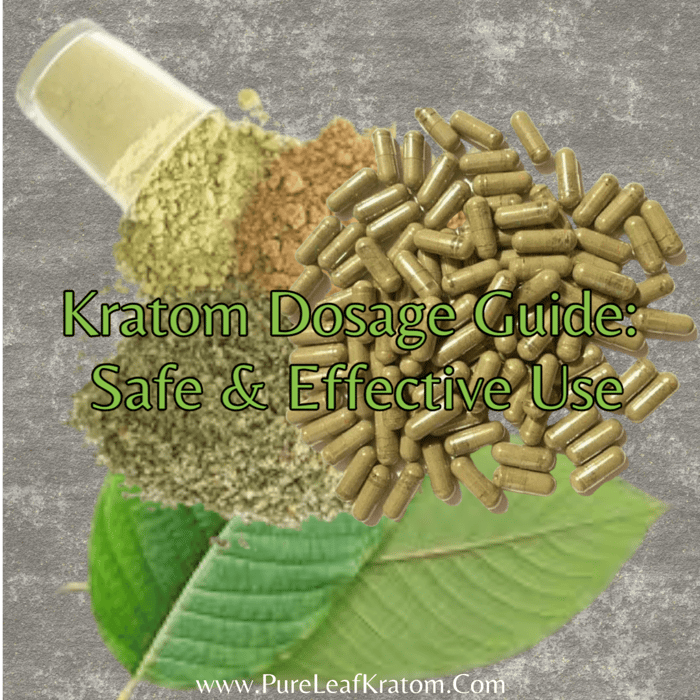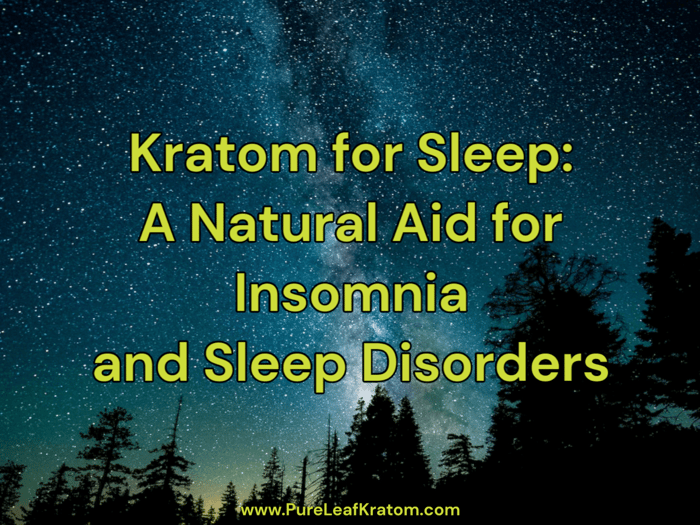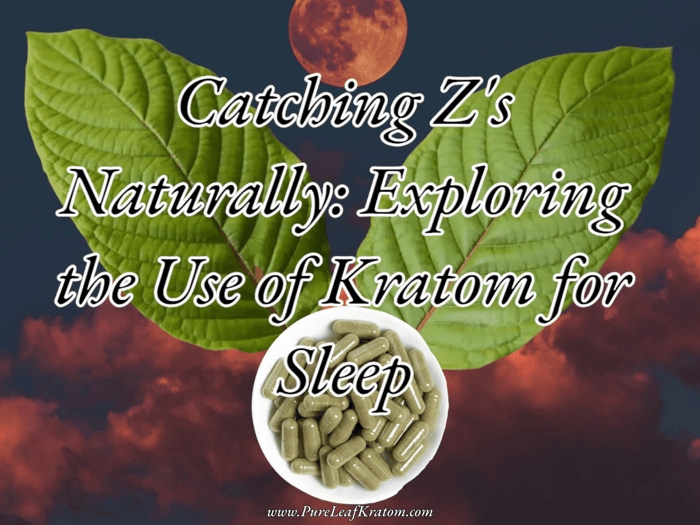
Catching Z's Naturally: Exploring the Use of Kratom for Sleep
Unwinding Naturally: The Intriguing Potential of Kratom for Sleep
Present times witness a flourishing interest in holistic health, with people increasingly seeking natural, alternative sleep aids. Here, one noteworthy contender is Kratom for sleep - a tropical tree native to Southeast Asia, emerging as a potential godsend for the sleep-deprived folks. Widespread traditional use of kratom has piqued interest among scientists and casual users alike, willing to reap its multifaceted health benefits, particularly sleep enhancement and relaxation.
The Roots and Roles of Kratom
Dipping into a bit of history, kratom or Mitragyna speciosa is a member of the coffee family originating from Southeast Asia. It has been a mainstay in traditional medicine as a restorative tonic for manual laborers and an analgesic for pain relief. The leaves of the kratom tree are abuzz with psychoactive compounds like mitragynine and 7-hydroxymitragynine that interact with opioid receptors in the body, exhibiting both stimulating and sedative effects.
Linking Kratom and Sleep
A growing body of evidence suggests a potential role of kratom for sleep in helping alleviate sleep problems. The kratom alkaloids exert opioid-like effects, including euphoria and sedation, thereby potentially fostering a relaxed state conducive to sleep. The ability to mitigate pain and anxiety further strengthens kratom's credential as a sleep aid. However, it's worth noting that the implications of these benefits are still under investigation. The inconsistencies in kratom's legal status across countries and the FDA's guarded perspective on kratom also complicate the picture.
Scruting the FDA's Stance on Kratom
The FDA has appraised kratom with a fair share of skepticism. While acknowledging kratom's vast medicinal potentials such as pain relief, opioid withdrawal management, and possibly sleep enhancement, they highlight the pressing need for establishing clear-cut guidelines for safe consumption. Concerns over kratom's potential toxicity, health risks linked with chronic high-dose use, and sporadic reports of organ damage underscore the need for more rigorous research.
Weighing the Prospects
Despite these concerns, there is optimism centering the potentials of kratom for sleep. Botanical composition aside, the actual effects of kratom hinge on the strain type, as not all strains are designed equal. The red, white, and green kratom strains present with differing alkaloid profiles that influence their therapeutic applications, including sleep enhancement. The ensuing section will shed light on the applicability of specific kratom strains as sleep aids, with an emphasis on red-veined strains - the sleep-conducive champions.
$9.95 Raw Kratom Capsules Red Kali Raw Kratom Capsules Red Kali emerge as an embodiment of potency and strength, tailor-made for both seasoned kratom enthusiasts and...… read moreRaw Kratom Capsules Red Kali

Kratom Strains and Sleep
Choosing the right kratom for sleep is crucial when looking for sleep support. The effects of different kratom strains on sleep patterns seem disparate, with some acting as energizers and others exerting sedating and calming effects. Primarily, red-veined kratom strains, known for their calming properties, are considered more beneficial for promoting restful sleep and are favored over their white and green counterparts for this purpose.
The Significance of Strain Selection When Considering Kratom for Sleep
Selecting the correct strain of kratom for sleep is pivotal, given the contrasting effects of different strains. Let's delve into the comparative analysis of red, white, and green kratom strains.
A Comparative Study of Red, White, and Green Kratom Strains
The subjective experiences of kratom considerably differ based on strain color. A survey studying the psychoactive differences between these kratom strains found red strains to be more sedating, green strains slightly more stimulating, and white strains the most stimulating of all. (source) What separates the red strain from the others is its significantly calming and sleep-inducing effects.
Scientific Analysis of Sedative Alkaloids Unique to Red Kratom Strains
Kratom for sleep: Kratom contains over 40 alkaloids, with the primary active compounds being mitragynine and 7-hydroxymitragynine. (source) Although it's yet to be scientifically established whether specific alkaloids are exclusive to red strains, user reportings align with the discovery that red-veined kratom strains, recognized for their calming effects, exert more robust sedative effects, aiding sleep.
Detail on Popular Red Kratom Strains with Sleep-Inducing Properties
Of the various types, three red strain creatums: Red Maeng Da, Red Bali, and Red Vein Kali are renowned for their potential as sleep aids.
Extensive Research on Red Maeng Da’s Potency and Effects
Red Maeng Da is a popular variety of red-veined kratom that's known for its potential to induce deeply restful sleep. However, exact effects may vary depending on the user's physiology and dosage.
Discussion on the Benefits and Drawbacks of Red Bali
Renowned for promoting relaxation and sleep, Red Bali's reputation as a strain precedes it. Though, like most herbal support agents, it may also come with certain drawbacks, such as nausea when consumed in high doses. Thus, starting with a lower dose and progressively increasing is advised, making it an option for those exploring kratom for sleep.
An Inside Look at Red Vein Kali with User Testimony Excerpts
Red Vein Kali, another strain celebrated for its potential sleep-promoting benefits, is sought by many users for its noted calming and analgesic properties, creating a favorable environment for sleep. However, users' experiences vary, and personal factors such as tolerance levels, overall health, and specific sleep concerns must be considered when exploring kratom for sleep.
Remarkable Herbs Kratom Powder Red Maeng Da
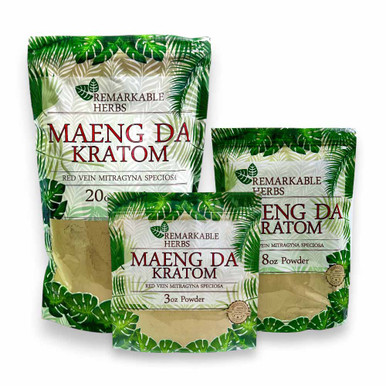
$9.59
Remarkable Herbs Kratom Powder Red Maeng Da Experience the pinnacle of Kratom excellence with Remarkable Herbs Kratom Powder Red Maeng Da, a product that embodies...… read more
Kratom Dosing and Timing
Discovering the optimal dosage and timing of kratom for promoting sleep is a journey that zigzags between individual tolerances, body responses, and the desired effects. As kratom is not a one-size-fits-all remedy, understanding the correct strategies will help fully harness its therapeutic potential while minimizing any accompanying risks. Let’s delve into the specifics.
Comprehensive Guide on Optimal Kratom Dosing
The optimal kratom dose varies from person to person and is contingent on multiple factors such as an individual's physical constitution, lifestyle habits, and sleep needs. However, there's a consensus that moderation is the gateway to beneficial outcomes. According to clinical insights, a standard kratom dosage falls within an estimated range of 2.5 to 15 grams. On the lower end, less than 5 grams could stimulate the mind, offering a boost of energy, whereas a middle range of 5 to 15 grams may induce relaxation and analgesia, potentially beneficial for sleep.
That being said, individuals new to kratom should always start with a minimal amount, slowly but steadily increasing the dose while observing their body's responses meticulously. Consistent use of products from a trusted and homogenous source can help ensure the reliability of the effects, as potency can vary across different products.
Assessing and Adjusting Doses Based on Individual Responses
Every individual reacts differently to kratom, especially when considering its potential for sleep support, due to unique physiological makeup and tolerance levels. Therefore, users should adopt a proactive approach, constantly assessing their responses and adjusting the doses accordingly for optimal results in managing sleep concerns. If relief isn't felt at lower dosages, one might consider upping the amount mildly over time, albeit under professional supervision.
Remember, higher doses within the range of 5 to 15 grams might be better suited for helping with sleep. However, side effects become more prevalent and the risk of dependence increases with high doses. Therefore, such adjustments should always aim for the sweet spot – the lowest effective dose.
Risks Associated with Overdosage and Kratom Combinations
Overdosing on kratom or combining it with other substances can lead to undesirable consequences. Frequent usage, especially in high doses, could elevate the dependency risk, leading to withdrawal symptoms. In addition, the interplay between kratom and other substances could result in unforeseen interactions - a potential peril zone left largely unexplored by scientific research.
Kratom's Pharmacodynamics and Pharmacokinetics
Delving into the pharmacodynamics and pharmacokinetics of kratom can help better understand its absorption, metabolism, and effect on the body. The major active alkaloid in kratom, mitragynine, displays opioid receptor activity, which is believed to underpin its therapeutic potential in pain relief and sleep enhancement. However, it’s also perceived to have a lesser risk of respiratory depression, a troubling side effect associated with conventional opioids.
Interestingly, kratom also exhibits non-opioid properties. The strains might augment antifungal drugs and contain anti-inflammatory properties. However, due to the dearth of research, well-rounded human dosage guidelines for its consumption are yet to be established. Hence, it's always advisable to embark on your kratom journey under the guidance of a healthcare provider.
Potential Side Effects and Safety Concerns
While the holistic health community and some kratom users highlight its potential benefits, there are documented side effects associated with its use. In fact, these side effects can be severe and, in some rare cases, life-threatening. It's essential to understand these concerns before moving ahead with regular kratom use.
Perils of Regular Kratom Consumption
The use of kratom, particularly on a frequent and regular basis, may lead to various adverse physical and mental health effects. These largely stem from the psychoactive compounds within the plant that interact with opioid receptors in the body. While these interactions can offer some therapeutic benefits, they also bring along a host of potential side effects.
Commonly reported side effects include nausea, vomiting, headaches, and irritability. Cardiac issues have also been noted among some users, likely due to the strain's stimulant-like effects at certain doses. Gastrointestinal, neurological, and psychiatric health effects have also been reported among kratom users.
Severe Side Effects: The Outliers
In rare cases, the use of kratom has resulted in severe health complications. While these are less common, awareness of such potential outcomes is crucial for anyone considering kratom for sleep or any other therapeutic use. Severe side effects include seizures, liver damage, and even mortality (often when kratom use is coupled with the use of other substances).
Pre-Existing Conditions and Kratom
People with certain pre-existing health conditions should approach kratom with caution. Although research into specific contraindications and health conditions related to kratom use remains limited, it's advisable that individuals with liver diseases, cardiovascular issues, or a genetic predisposition to seizures consult healthcare providers before using kratom.
Vigilance and Health Checks
Regular check-ins with your healthcare provider are recommended with ongoing kratom use, especially amongst those who opt for higher doses. This is to monitor any potential changes in health status, especially concerning the liver or cardiovascular risk.
Withdrawal Symptoms and Dependency Issues
Regular kratom use, particularly at high doses, can lead to physical dependency. Users may experience withdrawal symptoms if they attempt to stop using the substance abruptly. Symptoms can be akin to that of opioid withdrawal, including irritability, muscle aches, insomnia, and aggressive behavior. From studies, the onset of withdrawal symptoms is typically 12-48 hours after last dose, with the peak intensity at 72 hours and subsiding over a week.
Case Studies on Kratom Withdrawal
Profiles of endure withdrawal symptoms include those who've been habitual kratom users with intakes exceeding 3 glasses per day for many years. According to a Malaysian study on long-term kratom users, individuals consuming large amounts over prolonged periods could show elevated lipid values and moderate elevation of homocysteine, indicating potential increased cardiovascular risk.
In conclusion, while exploring kratom for sleep benefits, it's essential to acknowledge potential risks associated with its use. Understanding these risks, coupled with thoughtful strain selection, appropriate dosing, and regular health checks, can aid individuals in making informed choices about incorporating kratom into their sleep support regimen.
$9.89 Krave Kratom Capsules Red Dragon Red Dragon Kratom is a matured strain packed with pure potency. Krave Kratom Capsules Red Dragon offers Kratom consumers a pristine...… read moreKrave Kratom Capsules Red Dragon

Kratom vs Other Natural Sleep Aids
While the potential sleep-facilitating properties of Kratom have been widely discussed, it is equally important to contrast and compare this therapeutic substance with other popular natural sleep aids. Sleep enhancers such as melatonin, chamomile tea, valerian root, magnesium, lemon balm, passion flower, and l-theanine have all been used widely and have shown varying degrees of efficacy in supporting sleep.
Kratom and Other Sleep Inducing Substances
Kratom vs Melatonin: Melatonin is a hormone produced naturally in our body, and its role in sleep regulation is well-documented. Unlike Kratom, which has psychologically active elements and can lead to dependency, melatonin is considered relatively safe for long-term use. However, Kratom's analgesic properties may be beneficial for those who have sleep problems due to pain.
Kratom vs Chamomile Tea: Chamomile Tea, derived from the flowers of the chamomile plant, is a non-addictive and safe tea that is noted for its calming, soothing properties, making it one of the most commonly used natural sleep aids. While chamomile’s gentle effects work well for mild sleep disruptions, Kratom’s more potent psychoactive effects may be desirable for more serious sleep conditions.
Kratom vs Valerian Root: Valerian root is a plant extract known for its calming effects and it has been used as a sleep aid for hundreds of years. Its mechanism of action involves the GABA receptors, similar to some anti-anxiety medications. Unlike Kratom, Valerian root is not known for causing any dependency or tolerance.
The effectiveness of these other substances is less direct and possibly more subtle than the sedative effects of Kratom strains, but the risk factors associated with Kratom's use must be given due consideration. Moreover, research showing Kratom's efficacy as a sleep aid is not as extensive as that of these other substances and it’s important to remember that long-term kratom use can lead to dependence and side effects.
Additional Non-pharmaceutical Sleep-enhancing Techniques
In addition to considering natural substances as sleep aids, there are several non-pharmaceutical techniques that can greatly enhance sleep quality and duration. Activities such as meditation, music therapy, and light therapy, all aim to relax the mind and help induce sleep. This is alongside behavioral modifications such as decreasing screen time, maintaining a cool room temperature, avoiding caffeine close to bedtime, and employing blackout curtains to create an optimal sleeping environment.
Meditation and Music Therapy
Meditation practices can help quiet the mind, relieving stress and promoting relaxation. Incorporating mindfulness techniques at bedtime can help prepare the mind and body for sleep. Music therapy, such as listening to relaxing sounds or white noise, can also help to stimulate sleep through its calming effect on the nervous system.
Light Therapy and Sleep Hygiene Practices
Limiting exposure to screens before bedtime helps to manage exposure to blue light, which can disrupt sleep. Keeping your bedroom at a cool temperature, avoiding caffeine in the evening, and using blackout curtains to hold back any light during the night can significantly improve sleep quality. These are just a few sleep hygiene practices you can incorporate to enhance your sleep.
While natural sleep aids and practices, including kratom for sleep, can greatly improve sleep quality and duration, their effectiveness can vary. It’s important to consult a healthcare provider or sleep specialist to understand which might be most effective for you. Regardless of the method chosen, maintaining a balanced approach is crucial, especially when exploring substances like Kratom, which have complex effects and potential risks associated with their use.


